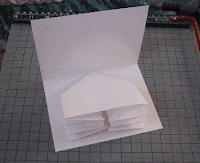

Six square gift cards from one sheet of card-stock
A bit of masking, stamping, and scoring, plus a few very simple cuts provide the bases for six 2 3/4” square cards. They’re so quick, easy, and cute; you’ll want to make a batch for every occasion!
• Start with a single sheet of 8 1/2” x 11” card-stock. Cut 1/4” inch off the width, leaving a sheet 8 1/4” x 11”. Score across the card-stock 2 3/4” from the top and from the bottom.

• Mask the top and bottom of the card to the score lines. Using a rainbow ink pad or multiple coors, randomly stamp images between the masks, being sure to stamp off the edges and onto the masks. Be random; make sure the images are stamped right side up, upside down, sideways. Try not to make an obvious pattern with the images. This is the same as the One Sheet Wonder technique, but only on the center portion of the sheet.
• When you’re done stamping, cut the sheet in half, making two 8 1/4” x 5 1/2” pieces.
• Next, cut each of the two pieces in thirds, making a total of six pieces, 2 3/4” x 5 1/2”. Fold and crease each of the pieces on the score lines.
• The cards can be used just as they are, or they can be embellished with layers of card stock, ribbons, buttons, or bows.

• To make a petal envelope, start with a square of text weight paper, 6" x 6". Cut squares 1 1/2" from each corner. Corner round the corners of all the tabs that are left. Fold the tabs in, tucking the edge under the one to its right. Use a sticker to seal the center.
* Note: These cards are NOT mailable, but they are perfect hand carried, or to accompany a gift.


































